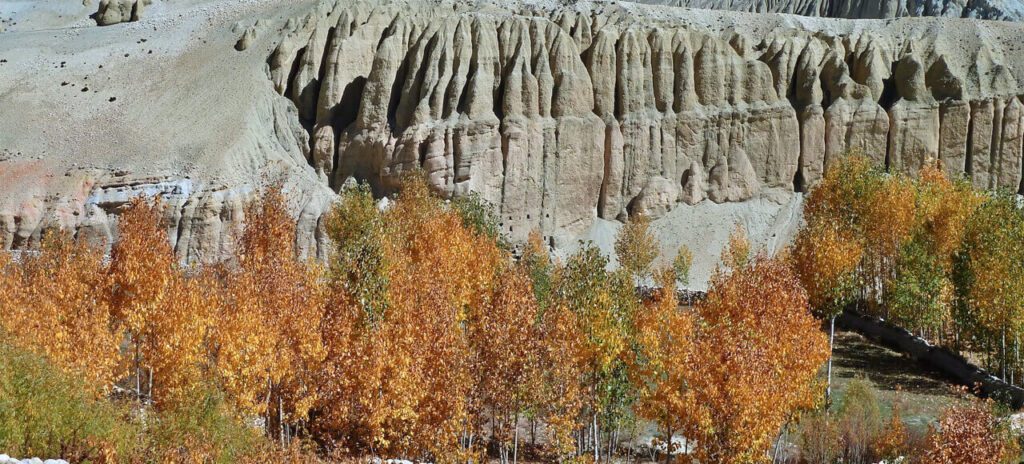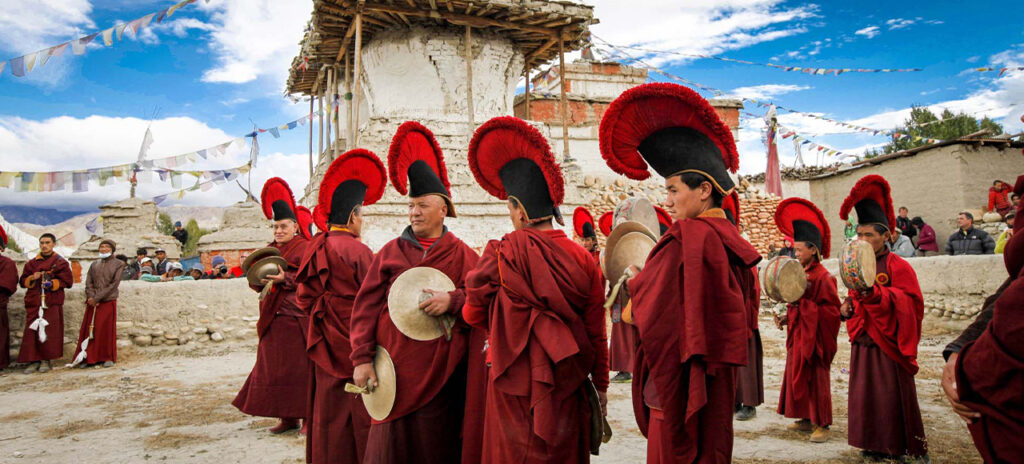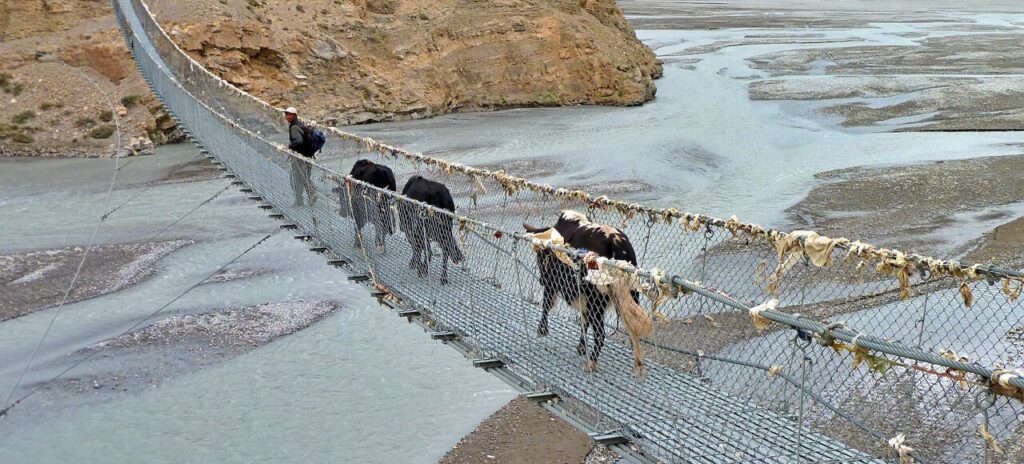The best time for the Upper Mustang Trek is during the spring and autumn seasons, offering clear and mild weather. These months offer the best opportunities for trekking and sightseeing, with clear views of the Himalayan mountains and colorful wildflowers in the spring. During the autumn season, visitors can experience the vibrant and colorful Thubchen Tsechu festival, which celebrates the Tibetan New Year.
Upper Mustang, dubbed the Kingdom of Lo, stands as a remote and restricted region within Nepal’s Himalayan kingdom. Once an independent kingdom, it still retains its status as a hidden kingdom, owing to its isolation and unique culture. Visitors to Upper Mustang can expect to see ancient Buddhist monasteries, intricate rock carvings, and stunning natural landscapes.
Highlights of Upper Mustang Trek
Scenic Beauty
Upper Mustang is a region in northern Nepal that is part of the country’s Trans Himalayan region. One of the major highlights of this region is its stunning scenic beauty. Upper Mustang’s landscape features snow-capped mountains, deep gorges, and the Kali Gandaki River, known as the world’s deepest gorge.
The snow-capped mountains of Upper Mustang offer a breathtaking view of the Himalayas. The region is home to some of the highest peaks in the world, including Annapurna, Dhaulagiri, and Nilgiri. Trekking in the Upper Mustang offers an opportunity to witness these majestic peaks up close.

The Kali Gandaki River, flowing through the region, forms the deep gorges of Upper Mustang. It has carved its way through the Himalayas, encircled by towering cliffs. The gorge is an impressive sight and offers a unique trekking experience.
The region also has the dry terrain of the Tibetan plateau, which contrasts sharply with the lush green valleys of Nepal’s lower parts. Upper Mustang is known for its dry deserts, canyons, and colorful rock formations. Small villages and monasteries dot the landscape, adding to its particular appeal.
Cultural Significance
Upper Mustang has a rich cultural heritage spanning back to ancient times. The territory was originally ruled by an autonomous monarchy that lasted until the late 18th century. Upper Mustang has its own distinct culture and language, which differ from the rest of Nepal.
Upper Mustang is also home to numerous ancient caves. Many of these caves were used as dwellings by the people of the region in ancient times. These caves serve as crucial cultural sites adorned with intricate murals and carvings. They reflect the religious and cultural beliefs of their past inhabitants.

Moreover, the region is also known for its colorful festivals and traditions. One of the most famous festivals in Upper Mustang is the Tiji festival. It is held annually in Lo Manthang, the region’s cultural and political center. The festival, marked by colorful masked dances and traditional music, celebrates the triumph of good over evil with offerings.
Trekking Experience
The trek to Upper Mustang is a highly rewarding experience for hikers and adventurers because it allows them to see the rugged beauty of the Himalayas up close while also interacting with locals and experiencing their hospitality.
Here are some of the key aspects of the trekking experience in the Upper Mustang:
- Remote and Off-the-Beaten-Path: Upper Mustang is a remote and off-the-beaten-path region in Nepal, so it is less crowded and provides a more authentic experience than other trekking destinations. Upper Mustang trek is an excellent way to escape the crowds and experience the Himalayan wilderness in its purest form.
- Stunning Scenery: As mentioned earlier, Upper Mustang is known for its stunning scenery, which includes snow-capped mountains, deep gorges, and the Kali Gandaki River. The trek offers breathtaking views of these natural wonders as well as the unique landscape of the Tibetan plateau.
- Unique Culture: Upper Mustang is also known for its unique culture, which is heavily influenced by Tibetan Buddhism. The trek offers an opportunity to interact with locals and experience their hospitality, as well as visit monasteries and ancient caves that reflect the region’s rich cultural history.
- Challenging Terrain: The trek to Upper Mustang is not an easy one as the terrain is rugged and challenging. Nevertheless, this also makes the trek more rewarding, as it requires a certain level of physical fitness and mental toughness. The trek involves crossing high passes and trekking through steep valleys, which adds to the sense of adventure and accomplishment.
- Lo Manthang: The walled city of Lo Manthang is the cultural and political center of Upper Mustang and is a major highlight of the trek. The city is home to several ancient palaces and monasteries, and its unique architecture and culture are a sight to behold.
Trekking Upper Mustang in Summer Season
Summer generally starts in June and lasts till August.
Monsoon Season
Nepal receives most of its rainfall during the monsoon season, which lasts from June to September. Upper Mustang, being in the Himalayan rain shadow zone, receives less rain than other parts of Nepal, but it still experiences some rainfall during this time. The roads can become muddy and slippery due to the rain, which can make transportation difficult.
Also, landslides and roadblocks are not uncommon during this season. Therefore, if you plan to visit Upper Mustang during the monsoon season, you should be prepared for the possibility of travel delays and changes in your itinerary.
Weather
During the summer, temperatures in Upper Mustang can get quite hot, with temperatures reaching up to 30°C or more during the day. The nights, on the other hand, can be cooler, with temperatures dropping to around 10°C. Therefore, it is recommended that you pack light and breathable clothing for the daytime and warm clothing for the night.
Also Read: Upper Mustang Festival: An Spiritual Heaven
Fewer Crowds
Since summer is considered an off-season for tourism in Upper Mustang, you can expect fewer crowds during this time. This can be an advantage, as you can explore the region in a more relaxed and peaceful manner without the crowds that you may encounter during the peak seasons.
Accommodation
As the number of tourists is relatively low during the summer season, finding accommodation in Upper Mustang may be easier than during the peak seasons. However, it is still recommended that you book your accommodation in advance to avoid any inconvenience.
Trekking
Trekking is a popular activity in the Upper Mustang, but the monsoon season can make the trails muddy and slippery, which can make trekking difficult. Therefore, it is recommended that you have proper trekking gear and be prepared for the possibility of difficult trekking conditions.
Trekking Upper Mustang in Autumn Season
Autumn usually starts in September and lasts till November.
Weather
The autumn season in Upper Mustang is characterized by clear skies, mild temperatures during the day, and cool temperatures at night. The average temperature during the day is around 20 degrees Celsius which is comfortable for hiking and other outdoor activities.
Fall Foliage
The fall foliage is a highlight of the autumn season in the Upper Mustang. The trees turn vibrant shades of red, orange, and yellow, making for stunning landscapes and great photo opportunities.

Mountain Views
The clear skies during the autumn season make for great views of the surrounding mountains. Upper Mustang is home to some of the tallest peaks in the world, including Annapurna and Dhaulagiri, which can be seen in their full glory during this time of year.
Tiji Festival
The Tiji Festival is a three-day Buddhist festival that takes place in May or early June, depending on the lunar calendar. During this festival, locals wear colorful traditional costumes and perform cultural dances and rituals. It’s a great time to experience the local culture and customs.

Peak Tourist Season
The autumn season is the peak tourist season in Upper Mustang, which means that there are plenty of accommodations and transportation options available. However, it’s advisable to book well in advance to ensure that you get the best prices and availability.
Upper Mustang in Winter Season
The winter season in Upper Mustang starts in December and lasts until February.
Unique Scenery
The winter season in Upper Mustang offers unique and picturesque scenery. The snow-capped peaks, frozen rivers, and icy landscapes create an enchanting winter wonderland that is different from any other season.
Fewer Crowds
Unlike the peak tourist season in autumn, the winter season in Upper Mustang is much less crowded. This makes it an ideal time for travelers who prefer more solitude and tranquility while exploring the region.
Local Festivals
The winter season is a great time to experience local culture and festivals in Upper Mustang. The Lhosar festival, which celebrates the Tibetan New Year, takes place during this season, which usually occurs in February. During this festival, locals perform traditional dances, and there are various cultural events and activities.

Trekking and Hiking
Although the winter season in Upper Mustang can be cold, it’s still a great time for trekking and hiking. The trails are less crowded, and the scenery is stunning, making it an ideal time for adventurous travelers. However, it’s important to be well-prepared and cautious due to the cold weather and potential challenges that come with traveling during this season.
Clear Skies
The winter season in Upper Mustang is characterized by clear blue skies, which offer stunning views of the surrounding mountains. The crisp and clear winter air also makes it an ideal time for photography and capturing some of the jaw-dropping shots of the Himalayan range.
Upper Mustang in Spring
Spring generally starts in March and lasts till May.
Weather
The weather in Upper Mustang during the spring can be described as dry and mild, with a relatively low chance of precipitation. The season typically begins in March and lasts until May, making it an ideal time to visit the region for trekking and sightseeing. The temperatures during the day in Upper Mustang during spring usually range from 10°C to 20°C, depending on the altitude and location.
The temperatures are generally mild, making it comfortable for trekkers and travelers to explore the region during the day. The nights in Upper Mustang during spring can be quite cold, with temperatures dropping to around 0°C or even lower, especially at higher altitudes. It is important to pack warm clothes, including a good-quality sleeping bag, to stay warm during the cold nights.
Natural Beauty
Upper Mustang is located in the rain shadow of the Annapurna and Dhaulagiri mountain ranges, resulting in a dry and arid landscape. The region’s high altitude also means that the air is thin and clear, offering unobstructed views of the surrounding mountains and landscapes. Upper Mustang is surrounded by some of the world’s highest mountains, including Dhaulagiri, Annapurna, and Nilgiri.
You may also like: Upper Mustang Trek in December: Travel Tips, Weather, and More
These towering peaks offer a stunning backdrop to the region’s rugged landscapes, and in spring, they are often still snowcapped, providing an added layer of beauty to the scenery. During spring, colorful rhododendrons and wildflowers adorn Upper Mustang, blooming in full splendor. The hillsides and meadows burst with a riot of colors, enhancing the picturesque scenery.
Cultural Richness
Over centuries, Upper Mustang has preserved its cultural richness along with its renowned natural beauty. Lo Manthang, an ancient walled city in Upper Mustang, stands as one of the region’s highlights. Home to the King of Upper Mustang, the city boasts renowned natural beauty and preserved cultural richness spanning centuries. Visitors can explore the narrow streets, white-washed houses, and the impressive royal palace, which is an excellent example of the region’s architecture. Upper Mustang is home to several traditional villages, each with its own unique culture and way of life.
Visitors can experience the local lifestyle, including the traditional clothing, food, and crafts that have been passed down through generations. Upper Mustang is home to several Buddhist monasteries and temples that offer insight into the region’s spiritual beliefs and practices. The monasteries also offer stunning views of the surrounding landscapes and are an excellent place to witness the region’s cultural richness. Upper Mustang is known for its traditional arts and crafts, including weaving, pottery, and metalwork. Visitors can observe the artisans at work and even purchase traditional crafts as souvenirs.
Trekking Routes
Upper Mustang is a popular trekking destination in Nepal, and spring is an ideal time to explore the region on foot. Here’s a closer look at the trekking routes in Upper Mustang during the spring.
Clear Routes
During spring, the weather in Upper Mustang is generally dry and mild, which means that the trekking routes are usually clear and easy to navigate. This is especially important in the Upper Mustang, where the terrain can be challenging and requires a certain level of physical fitness and preparation.

High-Altitude Trekking
The trekking routes in Upper Mustang are high-altitude and range from 2,900 to 4,200 meters, which can be physically demanding. Trekkers should be prepared for the high altitude and take necessary precautions, such as acclimatization days and proper hydration.
Scenic Routes
The trekking routes in Upper Mustang offer stunning views of the surrounding landscapes, including snow-capped mountains, deep canyons, and barren hillsides. The routes also pass through traditional villages, monasteries, and temples, providing trekkers with a unique cultural experience.
Challenging Terrain
The trekking routes in the Upper Mustang are challenging and require physical fitness and preparation. The routes involve steep ascents and descents, narrow paths, and the crossing of rivers and streams. Trekkers should be prepared for the challenging terrain and take the necessary precautions to avoid injuries.
In conclusion, the best time to visit Upper Mustang is during the months of April to June and September to November. During these months, the weather is mild and dry, making it perfect for trekking and exploring the region. However, it’s important to be prepared for extreme temperatures and high altitudes, regardless of the time of year you choose to visit. With the right preparation and planning, a trip to Upper Mustang can be an unforgettable experience.







